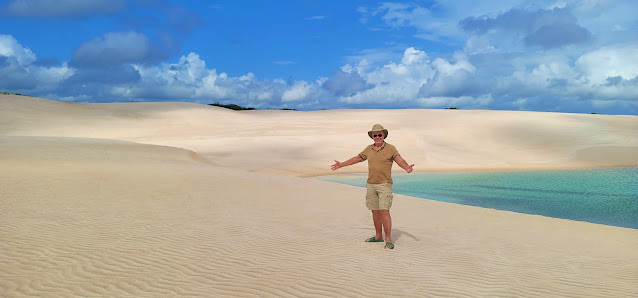
|
| At Brazil's unique Lençóis Maranhenses sand dunes, the highlight of this trip. |
My three northern coastal destinations
(left to right on the map above) were:- São Luís
- Lençóis Maranhenses (by the town of Barreirinhas)
- Jericoacoara
São Luís, Maranhão
With over a million residents, São Luís is the capital of Maranhão state and is especially known for its colonial old town.Right: The busy main pedestrian shopping street in the old town.
Lençóis Maranhenses
Lençóis Maranhenses is a geological anomaly! Nothing else like it in the
world — a vast expanse (600 sq miles) of sand dunes interspersed with
clear freshwater lagoons made possible by seasonal rainfall and a solid rock
layer under the sand.
Other sites may have sand and pools, of course, but no other place comes close to the hundreds of lagoons amid the dunes every year at Lençóis Maranhenses.
Incidentally, lençóis literally means “bed covering” or “sheets” in
Portuguese, but figuratively the word suggests smooth, flowing waves of
rumpled bed sheets, also white like the sand. Cool imagery. Gringos can
pronounce it “len-SOYS” without the nasal nuance.
From the nearby Barreirinhas airport, I took a 20-minutes flight out over the sand dunes and lagoons. June is an ideal time to see them when the lagoons are full.
The sand dunes came to an abrupt halt along a little ridge that shields the lush forest.
Tourists here are overwhelmingly Brazilians and Barreirinhas is not easily
accessible. Azul shut down the only flight here, so I had to take a long car
ride to get here from São Luis — plus another long car ride onward to
Jericoacoara. Nevertheless, happily for me, this dazzling geological oddity
has not yet been discovered by international tourism and is not yet overly
crowded.
Our 4-wheel drive Hilux dug deep into some loose sand. After several failed attempts, I wasn't sure we'd make it to the dunes that morning. But the guide and driver put lots of foliage under the wheels to provide traction and, after half an hour, we finally escaped.
We went early and (despite the sand trap) arrived before the noisy crowds and heat. I was the only tourist at Lagoa Bonita. The weather was mild with a fresh ocean breeze and clouds blocking the sun. And the unique vistas were strikingly beautiful.
All in all, the dramatic dunes and luminous lagoons of Lençóis Maranhenses were even more extraordinary than I had imagined they might be.
Tip: I used Rota das Trilhas for city transfers, Lençóis tours, and the flight. You'll need Google Translate (and may need to remind them you need to pay via Cielo, not Pix) but they are reliable.
Jericoacoara, Ceará
One of the most popular beach towns in Brazil is Jericoacoara (zhe-ree-kwa-KWA-ra) or just “Jeri” for short. (Its rivals include Búzios, Floripa, Porto de Galinhas.) Near the cozy town of Jeri, you'll find sand dunes with a few lagoons (although not on the scale of Lençóis), rock formations (especially one arch), and miles of beaches. Plus, its strong winds make Jeri a hub for kitesurfing and windsurfing.
 |
| My street shots were terrible so photos above are from destinosnotaveis.com.br, capitaothomaz.com.br, www.cvc.com.br. |
So many beach towns are shabby once you walk out of your nice resort. Sadly,
the Thai beach towns on Koh Samui and Phuket islands (where I was in May)
are filled with tawdry tattoo shops, cannabis dens, "massage" parlors, cheap
trinket stores, junk food stands, and odd places selling gold jewelry —
but not in Jericoacoara.
Jeri was surprisingly upscale with interesting shops and cafes. (Noticed
only two tattoo venues.) The whole town was somehow built on sand which added to its special allure.
Kite surfing does not hit its peak until August-November when powerful trade
winds blow almost nonstop. Nonetheless, I got to watch one talented kite
surfer zip along the coast and sometimes soar into the air and even do
summersaults before smoothly returning to the waves. He told me later he got
hooked on the rush 15 years ago.
Teresina
The largest city and capital of the state of Piauí is Teresina with
nearly a million residents. We had driven through Piauí's little coastal strip
(see map down below) on my drive to Jericoacoara, but I wanted to see more of
the state.
My favorite street was Avenida Frei Serafim with its tree-line pedestrian promenade in the middle.
Later on the promenade, I came across this striking, stylish scene. For
her final project, fashion design student Socorro Silva was doing a
photo shoot with her model.
Some Brazilian cities have large buildings that are run by municipal
governments and filled with small shops. Teresina's huge "Shopping da
Cidade" is packed with hundreds of tiny stalls (aka "boxes"). Of course,
Teresina also has an enormous, typical modern shopping mall as well.
Teresina has the classic "plateau skyline" that you see throughout Brazil
because city planners set height restrictions starting about 70 years ago.
Here is the sunrise view from my hotel room.
Visiting Piauí plus Maranhão brings my total up to 21 of Brazil's states with the five states in green yet to go.































